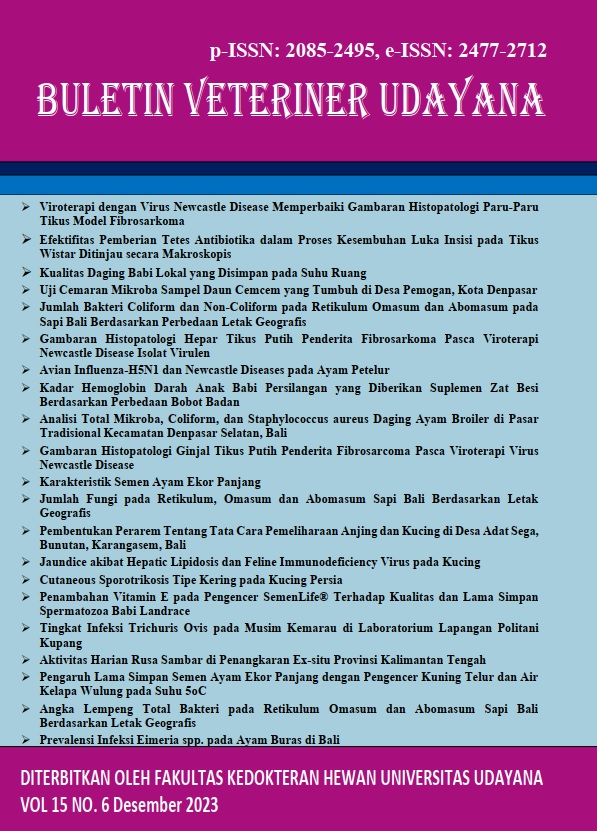BREEDER KNOWLEDGE AND APPLICATION OF BIOSECURITY ON QUAIL FARMS, KEDIRI CITY, EAST JAVA PROVINCE
Abstract
Quail is one of the poultry commodities that are increasingly popular in Indonesia. This is evident from the growing interest of people in raising quails and the increasing number of individuals consuming quail products, including eggs and meat. Quail farming has the advantage of being easy to maintain, but there are also several crucial aspects that must be considered to prevent quails from contracting diseases or outbreaks. This can be achieved by implementing biosecurity measures, which are essential factors in managing a farm. The research aims to measure the level of knowledge among farmers, the implementation of biosecurity, and the correlation between knowledge and biosecurity application in Quail Farms in the cities of Kediri and Kediri Regency, East Java Province. The goal is to enhance knowledge about biosecurity in quail farms in the mentioned areas and serve as a reference for further research and application. The research design used is observational (survey) on quail farms in Kediri City, utilizing a questionnaire in the form of a Google form. The collected data is then recorded and tabulated using MS Excel, and subsequently explained descriptively and qualitatively, presented in tables or graphs. The survey and observation results of quail farmers in Kediri City, East Java, show the following average outcomes: 86.5% have good knowledge, 7.5% have sufficient knowledge, and 6% have poor knowledge. Regarding the implementation of biosecurity, 30% were rated as good, 49% as sufficient, and 21% as poor. In conclusion, the knowledge of quail farmers in Kediri City and Kediri Regency, East Java Province, is considered good. However, there is still room for improvement in the implementation of biosecurity measures, as many farmers do not adhere to proper biosecurity management systems.
Downloads
References
Anggorodi. 1985. Mutakhir dalam ilmu makanan ternak unggas. Gramedia. Jakarta.
Blackwell M. 1997. Production biosecurity. Poult. Sci. 36(10): 50-53.
Brennan ML, Kemp R, Christley RM. 2008. Direct and indirect contacts between cattle farms in north-west England. J. Vet. Med. 84: 24-260.
Buhman. 2007. Penerapan biosecurity. Agromedia Pustaka. Jakarta.
Casal J, Manuel AD, Mateu E, Martın M. 2007. Biosecurity measures on swine farms in Spain: perceptions by farmers and their relationship to current on-farm measures. Prev. Vet. Med. 15(1-2): 138-150.
Damayanti R, Dharmayanti NLPI, Indriani R, Wiyono AS, Darminto. 2004. The clinico-pathological effects of chicken infected with highly pathogenic avian influenza in some farms located in East Jawa and West Jawa. J. Ilmu Ternak Vet. 9(2): 128-135.
Dinas Ketahanan Pangan Kota Kediri Jawa Timur. 2020. Populasi peternakan di Kota Kediri. https://kedirikab.bps.go.id/indicator/24/73/1/populasi-ternak.html
Direktorat Pembinaan Sekolah Menengah Kejuruan. 2014. Dasar-dasar kesehatan ternak. Kementerian Pendidikan dan Kebudayaan. Indonesia.
Dyah AM. 2016. Analisa kelayakan usaha peternakan burung puyuh dan pengepulan telur puyuh di Kecamatan Kras Kabupaten Kediri. J. Simki. Tech. Sain. 1(1): 1-21.
Fadilah R, Polana. 2011. Aneka penyakit pada ayam dan cara mengatasinya. Agromedia Pustaka. Jakarta.
Fadillah R. 2005. Panduan mengelola peternakan ayam broiler komersial. Agromedia Pustaka. Jakarta.
Grimes T, Jackson C. 2001. Code of practice for biosecurity in the egg industry. Barton Australia; Rural Industries Research and Development Corporation. AgriFutures. Australia.
Hadi UK. 2012. Pelaksanaan biosekuritas pada peternakan ayam. Thesis. Bogor: Institut Pertanian Bogor.
Johari S. 2004. Sukses beternak ayam ras petelur. Agromedia Pustaka. Jakarta.
Jubb T, Dharma D. 2009. Biosecurity risk management planning. A Training Course Manual Book. Australian Centre for Agriculture Research. Australia. pp. 16-24.
Mulyantini NGA. 2010. Ilmu manajemen ternak unggas. Gadjah Mada University Press. Yogyakarta.
Nawab A, Nawab Y, Tang S, Wu J, Liu W, Li G, Xiao M, An L. 2018. A pictorial guidebook on poultry diseases; diagnostic techniques and their effective treatment. Anim. Rev. 5(2): 34-50.
Rasyaf M. 2002. Beternak unggas komersil. Penerbit Kanisius. Jakarta.
Si Y, Wang T, Skidmore AK, Skidmore AK, de Boer WF, Li L, Prins HHT. 2010. Environmental factors influencing the spread of the highly pathogenic avian influenza H5N1 virus in wild birds in Europe. Ecol. Soc. 15(3): 26.
Solihin M. 2009. Risiko produksi dan harga serta pengaruhnya terhadap pendapatan peternakan ayam broiler CV AB Farm Kecamatan Bojong Genteng-Sukabumi. Thesis. Bogor: Institut Pertanian Bogor.
Steenwinkel SV, Ribbens S, Ducheyne E, Goossens E, Dewulf J. 2011. Assessing biosecurity practices, movements and densities of poultry sites a cross Belgium, resulting in different farm risk-groups for infectious disease introduction and spread. J. Prev. Vet. Med. 98(4): 259-270.





